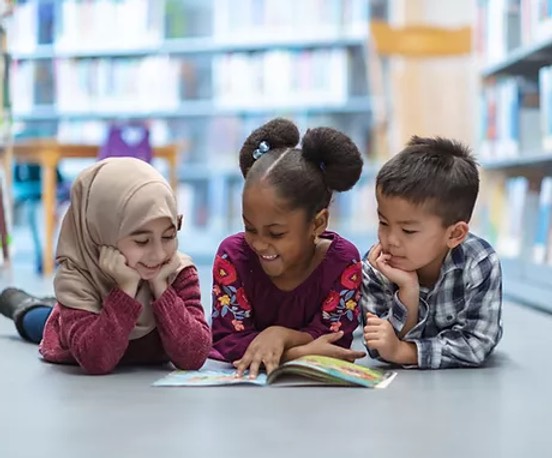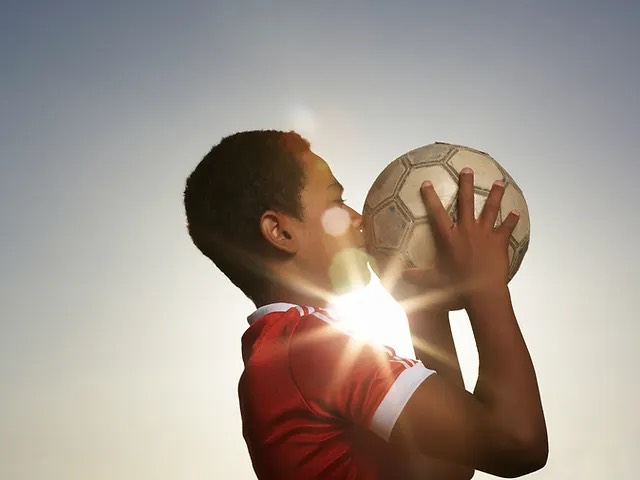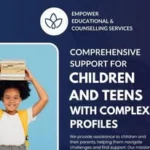Comprehensive Support for Children and Teens with Unique Learning Profiles
& Assistance to the Adults Surrounding Them

EMPOWER EDUCATIONAL
& COUNSELLING SERVICES
15+ years of experience
Dyslexia | Anxiety | ADHD | Executive Functioning | Mindfulness | Identity | Self-Awareness | Advocacy | Cultural & Intergenerational Trauma
Supporting Children Teens with Learning Differences & Emotional Health Challenges
At EmpowerECS, we support children and teens navigating learning differences—primarily dyslexia, ADHD, and executive functioning challenges. We also focus on mental health and well-being, offering practical strategies for managing anxiety, building confidence, and addressing socio-emotional barriers. Our approach combines realistic tools with neurodiverse-aligned resources, helping young people set meaningful goals and develop lasting skills that reach far beyond the classroom.
Empowering the Ecosystem: Teachers & Parents
We believe that truly supporting young people means empowering the adults in their lives. Parents, caregivers, and educators play a vital role in a child’s growth and well-being. That’s why we offer services designed to build their knowledge, confidence, and ability to respond with clarity and compassion. Through workshops, tutoring, counselling, and curated resources, we equip adults with the tools to better understand and support the neurodiverse learners they care for. Our approach fosters collaboration and open dialogue, creating a strong, connected support system where children can truly thrive.
Grateful to reside on the unceded, ancestrial lands of the Sḵwx̱wú7mesh (Squamish), Stó:lō/ Səl̓ílwətaʔ/Selilwitulh (Tsleil-Waututh) & xʷməθkʷəy̓əm (Musqueam) Nations.
Our experts can help you navigate the process and equip you with the knowledge you need to support your child effectively.
New: UNLIMITED MONTHLY TEXT SERVICES
We recognize that each child is different, and are committed to providing a customized experience that addresses their needs.
New: UNLIMITED MONTHLY TEXT SERVICES
Sessions are designed to address the specific needs of students, practitioners, or parents, offering targeted support and guidance.
New: MONTHLY CURRICULUM SERVICES
EDUCATIONAL PLANNING
SESSION
Support for Your Child’s Education
Has your child had a psycho-educational assessment? Do you know the next steps? We offer more than one-on-one sessions. Our Services: Goal Setting: Develop SMART (Specific, Measurable, Achievable, Relevant, Time-bound) goals. IEPs: Create and implement Individualized Educational Plans tailored to your child. Support Strategies: Discover the best programs and practices for your child’s needs.
Importance of Early Intervention & Collaboration
Early intervention is crucial from a neuroscience perspective. Brain Plasticity: The brain is highly adaptable in early childhood, making it easier to form new connections through learning. Critical Periods: Specific times when the brain is most receptive to learning; early intervention can have a significant impact. Our planning includes the entire support system: practitioners, teachers, and home support. Connecting all the key players in a child’s support network creates an idea wraparound approach.

TESTIMONIAL

COUNSELLING & WELLNESS
SERVICES
We are not one size fits all. We provide a fit for purpose approach to our services because we understand that our clients bring a unique set of contexts and needs to the table.
To achieve this, we use holistic, mixed-method approaches that are proven to meet specific goals, backgrounds and personality styles. Areas of specialization include anxiety (performance, social, PTSD, generalized), panic disorder, depression, trauma, loss/ grief, self-esteem, empowerment, and goal-attainment.
We provide care within in a variety of settings including virtual, in person, family, group or individuals.
TESTIMONIAL
MINDFULNESS & IMAGERY
IN PERFORMANCE
We provide sports therapy aimed at helping athletes improve their performance by incorporating mindfulness and imagery techniques. By incorporating mindfulness practices, athletes learn to cultivate present-moment awareness, allowing them to stay focused and fully engaged during training and competitions.
Additionally, imagery exercises enable athletes to vividly visualize successful performances, enhancing confidence and boosting mental preparedness. This form of sports therapy harnesses the power of the mind to optimize performance, allowing athletes to tap into their full potential and achieve their goals.
Through a combination of mindfulness and imagery techniques, we equip athletes with invaluable mental tools that can elevate their performance and overall athletic experience.

FOLLOW OUR
INSTAGRAM
FREQUENTLY ASKED
QUESTIONS
Activating and engaging as many parts of the brain as possible enhances the learning outcomes. We target auditory, visual, motor strip, kinesthetic and more, so that we get the most vibrant responses from our learners.
Factors to consider once you get going:
- Make all experiences teachable moments, by shared inviting experiences i.e. cooking, asking guided questions, and most importantly, waiting for the answer.
- Be process focused not results based.
- When reading, writing, or for art therapy, use as much white space as possible. Give ideas room to breathe.
- When writing, use lots of white space i.e. flashcards. Do not cram work on a page to “save” paper.
- Use visual images i.e. photographs that match concepts.
- Use colors, and drawings as triggers to connect to terms i.e. red for vowels
- Use video clips to support the visual and/ or auditory instructions or details.
- Chunk work and tasks to make them manageable, as well as to minimize confusion or feelings of being overwhelmed.
- Use multi-sensory manipulatives e.g., Lego pieces, paint, dried beans or blocks to help represent sounds and letters, words, concepts and patterns.
The pandemic tested our limitations and possibilities when it came down to remote work, education and mental health care. Almost overnight, the world changed and the way that we lived our lives day to day meant either doing without or adapting towards new operating systems.
In the world of education, dyslexia remediation and wellness therapy, having remote options became critical for supporting complex profiles and the surrounding families networks.
Initially there was very little optimism for online learning or mental health, but need drove progress, so the quality of lessons, digital tools and safe video conferencing platforms excelled rapidly. Families and practitioners were concerned about attention deficit, overall effectiveness, resources, access, and more. The choice became either do without the services or to give online a chance. Because the risk of no intervention was more harmful to the child, many families tried and and have not reverted back.
The learning space matters. The focus is the child’s needs, and creating a working space that is comfortable, equipped with what is required for learning and semi private. Because learning is individualized, it is always best to start with a brainstorm and engage the child by asking them to come up with a wish list of what their ideal space would look like, or feel like for them.
Some things to note:
- Comfortable seating.
- Stock up on supplies – pencils, notebook, other supplies including appropriate. technology and a stylus for touch screens and a pair of headphones.
- Pre-download any apps that are needed for learning.
- Test the WIFI, audio, annotation and video settings on your computers, iPad, or laptops.
Below are a few links to support you and your child on this online educational journey.
https://www.readingrockets.org/article/assistive-technology-kids-learning-disabilities-overview
Studying resilience has allowed me to understand how critical it is for me as an educator and mental health practitioner to understand its composition and nuances. The goal: to successfully enhance it within vulnerable student populations.
I initially looked at resiliency as a new term for an age-old topic that we could maybe even connect back to Darwinism or the Stoics. Is resilience not just the biological instinct of life preservation? We keep going because we’re hardwired to survive. I realized how much more complex, malleable, deep seated and fragile the notion of resiliency truly is, and how unique differences and culture factor in.
When the term resilience first appeared among professionals, consensus held it as a trait that someone either had or did not have. If you lacked resilience, you were simply ill-fated. Michael Chandler used metaphors of individuals (children) being like stainless steel or celluloid.
The stainless-steel kids would face adversity and appear to let it slide right off them, whereas the plastic kids would be bent and broken. That said, as the research into risk and resiliency continued evidence surfaced that this idea was short sighted and incomplete. Some children who initially appeared to fair well after traumatic events later demonstrated residual reactions and effects. These symptoms arising years after the trauma occurred. Not as cut and dry as “stainless steel or celluloid individuals.”
Researchers could not as easily predict the journey of trauma and its effects on resiliency as once thought. Resilience building is better understood as bi-directional interactions, rather than just a trait that one has or just does not. There are personal characteristics such as temperament that may affect a person’s ability to be resilient, but these qualities are only a part of the concept. Support of family, community, culture, education all play a role in the topic of resilience. Sometimes it only takes one person.
Emma Werner, who was ground-breaking for her time, challenged the pre-existing notion that a person from hardship should be considered damaged goods and doomed for failure i.e. steel or not (Werner, 1989). Werner’s work provided hope for individuals who were coming from these rough environments with traditionally bleak, unsuccessful looking outcomes.
Here work also affirmed that when the balance between stressful life events were met with a favorable balance of protective factors, adaptation, and thereby success was most certainly possible (Werner, 1989). Werner also affirmed that the child rearing conditions were greater determinants of outcome than just the perinatal environments (1989). This gave way to new ways of how to interact with at risk populations—especially children. One of the greatest things a practitioner could do was just connect, and care.
Do infants fair better as the are less aware of their surroundings, making them bulletproof to long-term effects of deprivation? The Romanian Orphanage Study and the related adoption studies were key studies that gave way to deeper realizations into the study of resilience and its detrimental relationship to early in life environmental deprivation. The studies showed extensive global deprivation, which meant infants and toddlers were deprived of food, resources, heat, medical care, emotional bonding, social interactions and offered jail-like, routinized care. The longitudinal studies showed that these effects were real in the babies that grew up into adults. If environment can be the risk factor, can it not support enhanced protection/ resiliency?
Neglect in early in infancy definitely left permanent and lasting effects in later development, but resilience could be reacquired if these individuals had protective factors, such as a supportive caregiver or adult in their lives (Schonert-Reichl). Walsh’s work confirmed that receiving warmth from at least one adult caregiver led to greater chances to build resiliency, and enhancement of success in adulthood (Walsh, 2002).
Embracing a strengths-based approach was also vital as it shifted focus to what was in an individual’s control. This enables families to build resources and assets, rather than working out of a deficit, trying to “fix” what may subjectively be stigmatized as broken (Walsh, 2002). Ultimately the design was to empower individuals to be able acquire the skills and resources to help themselves (Walsh, 2002). This could permanently enhance the functioning of an entire family unit.
Danish theologian Kierkagaard who spoke of hope in the following way:
“The passion for what is possible. It is not based on reality as it is not but based on reality as It may be possible tomorrow” (May, 2001).
Trauma and deprivation are risk factors, but the protective factors available to a person through education, relationships, community can rebuild their resiliency and teach coping skills. The ecosystem and environment are so vital, but only once an individual can trust that this environment is actually there for them. People must be heard, feel seen in a safe, non-judgemental space, especially by practitioners.
Why does this matter?
Each person is unique, with a individualized, and there is no cookie cutter approach.
The Hip-Hop Education Center is a non-profit organization where we focus on integrating various aspects of the Hip-Hop culture to education and mental health realms.
Data has demonstrated that Hip-Hop culture is a powerful and relevant cultural force that can be highly beneficial when integrated into education and mental health initiatives, particularly when emphasizing the arts and music. This assertion is grounded in a rich historical context that underscores the significance of Hip-Hop. Here are key points illustrating its historical relevance and benefits:
- Historical Roots in Marginalized Communities: Hip-Hop originated in the South Bronx, New York, during the 1970s. It emerged as a form of artistic expression and a voice for marginalized communities facing socioeconomic challenges, racial discrimination, and urban decay. Integrating Hip-Hop into education and mental health acknowledges its roots in resilience and creativity.
- Youth Empowerment: Hip-Hop has a history of empowering marginalized youth. It provided an avenue for young people to voice their experiences, struggles, and aspirations. In educational settings, it can serve as a vehicle for students to express their own narratives and experiences, leading to increased self-esteem and emotional well-being.
- Social and Political Activism: Historically, Hip-Hop has been a vehicle for social and political activism. Artists have used their platform to address issues like racial inequality, police brutality, and social injustice. This context reinforces the potential of Hip-Hop to promote critical thinking and advocacy among students, contributing to their social and emotional development.
- Artistic Versatility: Hip-Hop encompasses a wide array of artistic expressions, including rap, dance, graffiti, and music production. This artistic versatility makes it suitable for diverse learning styles and preferences. It encourages creativity, self-expression, and skill development, all of which are integral to arts-based education and mental health therapy.
- Cultural Connection: Hip-Hop is deeply rooted in the African diaspora and urban culture. It resonates with individuals from diverse backgrounds and can serve as a bridge to connect with and engage students from various cultural backgrounds. This inclusivity enhances cultural sensitivity in education and mental health programs.
- Resilience and Growth: Many Hip-Hop artists have risen from challenging circumstances to achieve success. Their stories of resilience and personal growth can serve as inspirational models for students. In a mental health context, these narratives can demonstrate that adversity can be overcome.
- Community and Collaboration: Hip-Hop culture places a strong emphasis on community and collaboration. Engaging in collaborative creative projects within the Hip-Hop framework can foster a sense of belonging, teamwork, and emotional support, vital in mental health initiatives.
- Creativity in Healing: Hip-Hop offers innovative and creative approaches to healing and self-expression. Through elements like lyricism and dance, individuals can address trauma and emotional challenges, fostering emotional growth and well-being.
Incorporating Hip-Hop, or just any arts or music into education and mental health initiatives recognizes its historical role as a platform for empowerment, social engagement, and artistic expression. It acknowledges the relevance of Hip-Hop to the experiences of marginalized communities and positions it as a valuable tool for fostering creativity, self-expression, and well-being in individuals


